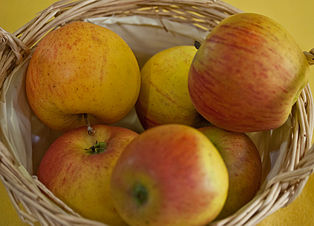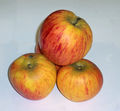Gold parmane
| Gold parmane | |
|---|---|
| Synonyms | Winter Goldparmäne, Goldrenette, Queen of the Renettes, King of the Pippins |

|
|
| Art | Cultivated apple ( Malus domestica ) |
| origin | possibly France |
| ancestry | |
| List of apple varieties | |
The Goldparmäne is a cultivar of the cultivated apple . For many centuries, the apple was considered one of the best dessert fruit varieties. The high esteem of this variety is also expressed in the French denomination of Reine des Reinettes (Queen of the Renettes ). However, the golden parmane has almost disappeared from the range of modern commercial cultivation, as it is very susceptible to disease and pests and can only be produced with great expertise in cutting and care. The Goldparmäne is one of the oldest apple varieties. It was probably created in Normandy around 1510 .
fruit
The apple is spherical to tall with a wide or almost flat calyx surface. The basic color is green-yellow to yellow. The body color orange turns into red. Light stripes can be seen. Flowering begins in the second half of April and ends in early May. The fruits have a typical nutty aroma and are relatively low in acid. The fruits are prone to glassiness and speck .
Maturity
With the relatively early harvest from the end of September that used to be common, the apples had to be stored for a few weeks before consumption and were then ready to be eaten from October to January. When the storage time in the natural camp (in contrast to the CA camp that is common today ) was well advanced, the shell collapsed, which at that time was only regarded as a blemish. It is also possible to leave the apples on the tree until they are ready to eat, but then, as with some other varieties, there is a limited amount of natural fruit fall. During post-ripening in storage, the fruits, such as bananas , naturally excrete ethylene , which greatly accelerates fruit ripening if there is insufficient ventilation.
Habit
The Goldparmäne is very apical-dominant , that is, especially when the tree is still young, the leading branches pull steeply upwards. This can be counteracted by pruning, but better by tying down long, steep shoots, which thereby set flower buds and are strongly inhibited in further vegetative growth. When the tree is tied down, it develops plenty of whorl wood , which blooms and bears abundantly . Is there an older tree mainly from Quirlholz, is usually a thinning of the fruits necessary to achieve an adequate fruit size and alternation to prevent. A thinning to one fruit per inflorescence is also necessary to prevent premature fruit fall, as the golden parmane has very short-stemmed fruits which, as soon as they become larger, push each other off.
literature
- Walter Hartmann : Color Atlas of Old Fruit Types. 5th edition. Stuttgart 2015, ISBN 978-3-8001-0316-4 .
- Martin Stangl: The FSVO manual fruit. Munich 2018, ISBN 978-3-8354-1820-2 .
Web links
- Index card of the variety in the BUND-Lemgo fruit variety database



